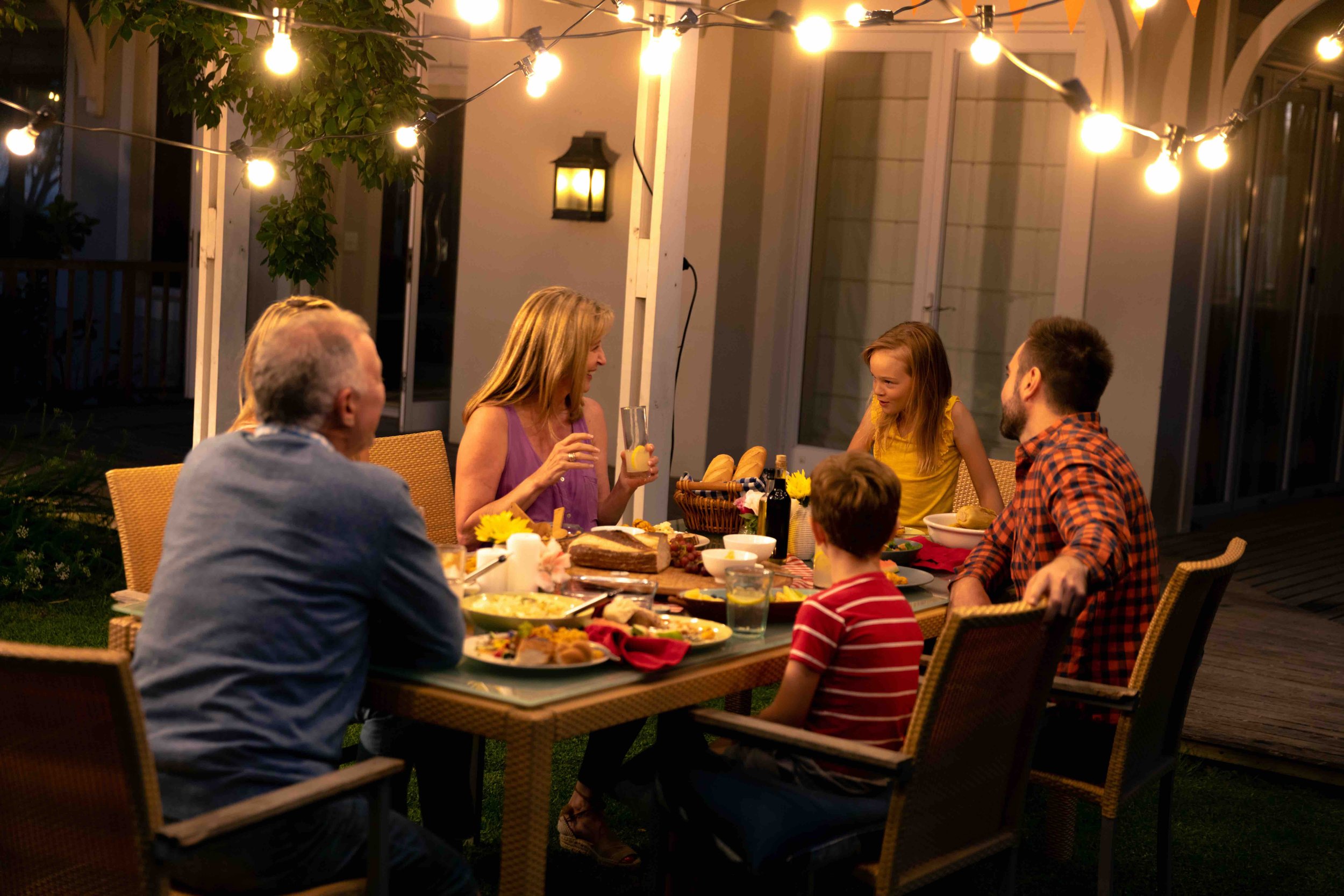Your Guide to Landscape String Lights: Adding Some Magic to Your Backyard
One simple way to transform an outdoor living space is a tactic that most people associate with the holidays: string lights. String lights are so much more than holiday decorations, however. Many homeowners and even business owners use string lights to build a visually interesting environment. Adding string lights is fairly straightforward. However, they work best when they’re part of a professionally designed landscape lighting system. In this article, we’ll cover frequently asked questions about adding some magic to your backyard: your guide to landscape string lights.
outdoor lighting
landscape lighting
patio lighting
string lights
What Are String Lights Called?
String lights have many different styles and uses. The most common version you might see is the type you’d put up around the holiday: Christmas lights are the original string lights. Today, they have evolved into bona fide outdoor lighting for gathering spaces. They’ve come a long way, too, in technology. Where previously you had to deal with burned-out bulbs and strings that only lasted a season or two, today’s light-emitting diode (LED) string lights last much longer - and they come in a huge array of styles. The bulbs are connected by a string in several different arrangements, even set to different colors and timings to create a festive light show.
What’s The Difference Between Fairy Lights And String Lights?
Fairy lights are string lights, but not all string lights are fairy lights! Fairy lights are composed of tiny LEDs and are just one category of string lights. They look amazing when placed in glass containers or within the landscape. Many are battery-operated which gives you endless design options. They are not intended as a primary source of light, unless of course you get lots of fairy lights and use them all around your outdoor living space.
What Are The Different Types of String Lights?
There are several different types of string lights intended for a variety of functions in the landscape. Before hanging string lights in your outdoor living space, consider how each one will improve the space. Let’s cover some of the most common types of string lights:
Fairy Lights: Fairy lights are tiny, often battery-operated lights that are commonly incorporated into centerpieces, floral arrangements, or throughout the landscape as delightful little pops of light.
Christmas Lights: You can certainly use Christmas lights in your landscape and enjoy a variety of styles - but be aware, traditional Christmas lights will not have the lifespan of a quality LED string light. A tasteful arrangement around the holidays will create a magical feel outside the house, though the weather will mean you’ll want to warm up with space with a fire pit and hot apple cider. Some Christmas light-style string lights come with a variety of bulb covers that can be added or removed to suit the mood: some non-holiday styles include plastic beer mugs, dragonflies, and globes. Just be sure to choose non-flickering Christmas lights if you’re going to use them in an outdoor living space where you want tranquility.
Globe Lights: Globe lights use larger glass spheres. This makes an outdoor environment glow brightly and take on an exciting visual tapestry that enhances your parties.
Edison Lights: Larger string light styles include vintage-style Edison bulbs; and yes, they’re still LED so they’ll last much longer than any vintage incandescent bulb (and they’re completely weatherproof as well).
Rope Lights: As the name might suggest, these lights look like rope that’s lit from within. The light fixtures are placed within the “rope,” creating a smooth texture on the outside and reducing the amount of untangling you need to do to install them. These types of lights are perfect for helping to illuminate the perimeter of a patio or a walkway.
Stringed Lanterns: A set of string lights that uses larger lanterns can be as varied as classic Asian paper lanterns, vintage steampunk lanterns, modern metal and glass lanterns, and more. These types of lights are perfect for adding flair to a gathering space and creating a magical atmosphere for all your outdoor events.
How Do You Hang String Lights?
Once you choose the right string lights for your space, installation is a breeze! You’ll want to install hooks on any structure you want to hang lights from. Then, just drape your lights between the hooks. Be sure they’re hung at least 8 feet high overhead to make your taller friends/family feel like they have some head room.
How Much Should A String Light Cost?
The initial purchase as well as ongoing electricity cost depends on the style and length of the string lights.
You get what you pay for. Cheap incandescent Christmas lights can cost as little as $10 but you’ll pay extra in electricity and they won’t last more than a season or two. By contrast, quality LED string lights are more expensive initially - $30 and up - but you won’t need to replace them for upwards of a decade, and your electric bill will be lower as well. In the long run LEDs are a much more cost-effective alternative.
On average, basic string lights in a 1,000 light set use $0.14 per kilowatt hour of electricity. Larger and brighter string lights in a 100 light set run upwards of $1.62 per kilowatt hour. When turned on for a six hour gathering in the evening, this can be as little as $0.03 per evening or up to $0.40.
Are Outdoor String Lights Safe?
Absolutely! It’s important to keep your string lights in the right conditions, however. Incandescent bulbs will let off heat, so they shouldn’t be kept in close proximity with each other while turned on. They should also avoid touching highly flammable materials. LED bulbs generate very little heat which opens up placement options. Even though they’re outdoor-rated, string lights should not come in direct contact with water. You can wrap electrical tape where you plug one string into another to keep moisture out; and be sure outdoor electrical outlets have a cover.
Are LED Lights A Fire Hazard?
LED lights don’t generate heat, so the fixtures themselves are not a fire hazard. What can cause fires is an overloaded circuit (which can spark) or faulty wiring. If your home is older, it’s a good idea to check the safety of your outdoor electrical outlets with a professional electrician before installing string lights.
What Voltage Should A String Light Be?
Christmas lights are designed to be low voltage since they’ll be in close contact with a tree for upwards of a month. They often use no more than 4 volts.
However, landscape string lights can use up to 120 volts. This isn’t out of the ordinary for a lighting system, but it’s important not to overload an outlet with more than one string light set per plug. If you need more electricity, it’s important to install a landscape lighting transformer so you can safely operate all your landscape lights.
What Is The Best Color For String Lights?
Warm whites are the best color to use in string lights, which is indicated by a color temperature of 2700K or lower. Brighter colors with a higher color temperature (over 3000K) are often too harsh and overbearing for an outdoor living space. Warm whites will put people at ease in your backyard. If you want to create more of a romantic setting, go with the warmest color temperature you can: 2000K or lower. Colors that mimic candle light are the most soothing.
What Length String Lights Should I Get?
First, measure your outdoor living space. String lights are hung with a little slack so account for that and add between 2 to 6 feet to your string light length so that they can hang a little loose, dangling and swaying beautifully in the breeze.
Less is more with string lights. We recommend getting just enough to cross your outdoor living space at an angle. If you need more light, add another length to create an X across the space.
Where Is The Best Place To Buy String Lights?
Home improvement stores and online retainers will have a great selection of both traditional Christmas lights and more upscale landscape string lights. If you want fairy lights, craft stores are your best bet.

